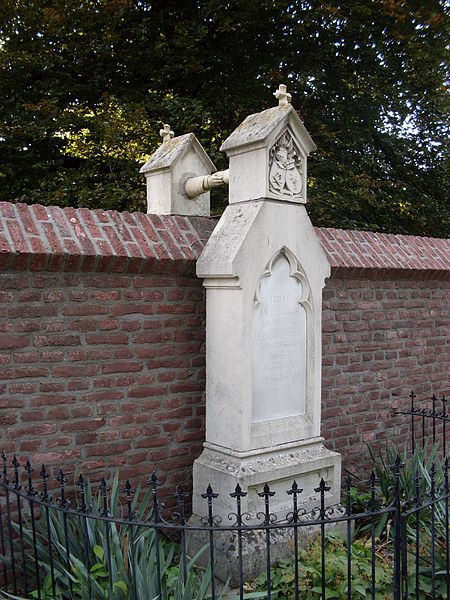Until Death Do Us Reunite
In 1945, as World War II came to a close, various tiny political factions sprouted up across Europe. In the Netherlands, for example, a group of socialists formed the Dutch People’s Movement, Nederlandse Volksbeweging (“NVB”), in hopes of ending over a century of segregation called “pillarisation.” Pillarisation, unlike the types of segregation that Americans are historically more familiar with, is vertical — no one group is considered by society at large to be more important than another. (One could argue that pillarisation truly aimed to be a “separate but equal” form of segregation, if such thing is possible.) In the Netherlands, pillarisation divided society primarily along religious lines, with Catholics and Protestants living, effectively, in separate societies.
Which led to the grave sites, below.

In 1842, a colonel in the Dutch cavalry, JWC van Gorkum, married a woman known as JCPH van Aefferden. The union was controversial — van Gorkum was Protestant and van Aefferden was Catholic. Despite the prevailing culture at the time, the two remained married for decades, only separating when van Gorkum died in 1880. He was buried in a cemetery near the Dutch town of Roermond called Begraafplaats Nabij de Kapel in ‘t Zand (“the cemetery near the chapel in ‘t Zand”). Pillarisation was taken very seriously — each community had its own schools, media, and graveyards — and Begraafplaats was no different. It took this segregation literally, with each religion having its own section. Van Gorkum was buried in the Protestant section, as would any other Protestant during that era.
But when van Aefferden passed away eight years later, she couldn’t be buried with her late husband; even in death, Catholics needed to stay with their own. While alive, she made her wishes clear — she did not want to be buried in her family tomb, and, instead, wished to be as close to her husband as possible. The solution, seen above, is her grave site. (Here’s a bigger version of her tombstone, and here’s his.) The two tombstones, separated by a wall and by religions, feature a pair of hands connecting over the brick divider.
It’s an elegant workaround to an inelegant set of rules, and a workaround which outlasted pillarisation. The NVB was successful in changing Dutch culture by the mid-1960s.
Bonus fact: In 1935, a Romanian sculptor named Stan Ioan Patras took to a local cemetery and began sculpting graphical epitaphs on tombstones, demonstrating how the deceased died (often with a poem as well). The tradition continued on past Patras’ death in 1977 and the cemetery, located in the village of Sapanta near the Ukrainian border, is now known as the Merry Cemetery. Here’s a photo gallery. (And here is Patras’ self-created grave site.) As the BBC reported in 2002, the cemetery has become quite a tourist attraction, with visitors often purchasing custom-made grave markers from the artists in residence.
From the Archives: Scrambled City: How parts of the Netherlands and Belgium got mixed up with each other.
Not Related: Instead of linking to something about graveyards or tombstones (which would be terrible), here’s a reminder to check out AwesomeClaus.com, my site of fun gift ideas under $20.
